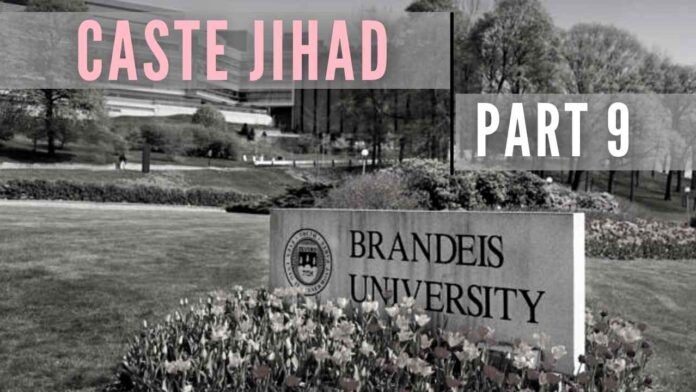
The previous 8 parts of the article can be accessed here Part 1, Part 2, Part 3, Part 4, Part 5, Part 6, Part 7, Part 8. This is the ninth part
Caste at Brandeis University
In our continuing series on Caste Jihad (see from 1-8 here), this part begins with the higher education institutions where the “caste” has been categorically added in the nondiscrimination policy. Brandeis University in Boston area is the first who took this step in 2019 followed by a bonanza in 2021 with many institutions (Colby College; the University of California at Davis and San Diego, California State University, and Harvard) adopting similar resolutions. It is like a “Caste-Cult,” in the making with caste added with identifiers like race, religion, gender, national origin, etc., in nondiscrimination policies. It is interesting that almost all institutions cite the infamous but highly questionable and unscientific Equality Labs survey claiming the origin of casteism with only Hinduism with no truth to that end.
With 35 years of experience in higher education in the U.S., I have reviewed caste-based decisions from a different lens. For example, is the policy driven by student, faculty, or both and who took the lead and why? Are the faculty members engaging in caste jihad as a toolkit to advance their scholarship to proclaim themselves as the world’s expert on dismantling social barriers? On the contrary, the caste jihad is creating social barriers and gaps among people of Indian (and South Asia) origin and between them and the local communities. This article critically analyzes what drove Brandeis to embark on this journey. Other institutions will be discussed in future articles.
Reportedly, Brandeis “added caste, a social hierarchy that exists in some South Asian communities, to further protect its diverse student body, faculty, and staff,” according to University President[1]. I ask why the “decision was not made because of any specific incidents of caste discrimination on campus,” according to the university’s chief diversity officer at the time. I assert that caste is inherently rooted in one’s race, religion, and/ or national origin and so why to make it a separate category. This will be clearer when Colby College policy change is discussed in the next article. It is important to underscore that EEOC policy is adequate to deal with any complaint alleging discrimination and no policy changes are warranted.
The media report also cited the enrollment in fall 2018 with 90 of the university’s 1,571 international students from India[1]. Notwithstanding that all students must be protected against any form of discrimination; it is hard to believe that the policy change was driven because of less than 6% of Indian students with no complaints as stated above.
Granted that some students from South Asian countries may have caste-related tendencies but it can’t be the driving force that has the potential to perpetuate undue and hitherto unheard caste discrimination on the campuses and in American culture. Does the university have the know-how to understand and implement the complex caste hierarchical system imposed during the colonial period? In fact, such policy will harm the Indian American students who are generally unaware of the age-old caste system yet they may be falsely accused and subjected to reverse discrimination. Additionally, the staff and faculty of first-generation immigrants of Indian origin may face “silent” discrimination in hiring and promotion on the assumption that they carry the caste baggage.
The truth about Brandeis is that Professor Laurence Simon[2], Director of the Center for Global Development and Sustainability (GDS), worked with a committee mostly comprised of students and faculty members with Indian ancestry to address caste in the university’s nondiscrimination policy[3]. Reportedly, Simon said, “Caste is a very powerful indicator of social status and opportunities mostly in South Asian countries, but also in the diaspora of Asian countries in the U.S. and it’s largely hidden[1].” “There’s a sense of caste that’s very ancient but very present…I wouldn’t be surprised if there are other universities in the U.S. where an understanding of caste is held by people in the campus communities.” The reference to other campus communities is to what I call the “caste-cult” he may know and interacts with. As a longstanding member of the Indian diaspora, I have never perceived and/or heard about the “hidden” caste issue on 8 campuses in my career of 35 years let alone the caste being a very powerful indicator of social status.
Reportedly, Simon visited India[2], Nepal, and Sri Lanka many times, thus his exposure to casteism. Interestingly, Simon observed that his “decades of research work in India” surprised him “how powerful caste identities still were and how a sense of privilege or exclusion derived from them.” He went on to say, “The concept of caste and caste discrimination is not something to which most Americans are attuned, and therefore even discrimination might be hidden to our eyes.” I wonder, how Simon himself got tuned into the caste system?
A quick review of Simon’s documented scholarship on caste issues shows his earliest work in 2013 and not the ‘decades of research work[4].’ In fact, what is listed is not necessarily research by most accounts in academia. These are conference presentations and/ or published in a journal (CASTE: A Global Journal on Social Exclusion) started by Simon at Brandeis in 2018. Simon is the joint Editor-in-Chief of the journal with another Editor (Sukhadeo Thorat) from India. Thorat is an emeritus professor, honorary chairman of the Indian Council of Social Science Research, and the former Chairman of the University Grants Commission. This may explain how Simon got tuned into India’s historical caste-ridden practices against Dalits like Thorat, who could not have faced discrimination rising to a very high-profile position. This signifies that caste-based discrimination is continually declining while caste-associated benefits rise in education and employment opportunities for Dalits and thus helping realize Ambedkar’s dream.
Simon also led an annual conference on caste and race issues starting in 2015. The first three conferences were held at Brandeis and then hosted as a “floating conference” by different universities. It seems that the last conference was in 2019 just about when the Journal was initiated. I surmise with strong conviction that Simon was working toward his prominence as an authority on caste. It is not just Simon but many professors in the West seek the status as “experts” on social, political, religious, economic issues in India and South Asia. They infiltrate academia, help change the narrative in media, and influence policy-making in India.
In my assessment, Simon led the caste policy to the highest level to add one more feather in his cap. There were no caste discrimination complaints in 2019 at Brandeis and perhaps none since then. However, Brandeis notoriety triggered similar policies silently at other campuses. I am afraid that faculty members like Simon and some of South Asian descent abuse the academic freedom to seek short-term personal notoriety for longer-term and broader negative social consequences. It is an excellent goal if Brandeis wants caste-free admission and faculty recruitment policies but is Brandeis ready to learn about hundreds of castes and subcastes in the hierarchical complex web? I am afraid that even someone like me, who has grown up with that system, does not understand the complex caste web.
I wonder if Professor Simon’s association with Ford Foundation in India (and Soros Foundation too) influenced and advanced his scholarship about caste as a social issue in India. Both Foundations have a history of supporting projects which disrupted India’s social fabric and were disallowed to transfer foreign funds under FCRA.
Let me mention that I called President’s office at Brandeis about the policy in question; they directed me to the Provost office but the call was not returned. Similarly, a voice mail left for one professor of Indian descent at GDS and a member of the Faculty Senate at Brandeis, and another for a professor in Alabama (mentioned in the report[1]) were not returned.
In my informed opinion, the caste in nondiscrimination policy at Brandeis was a faculty-led initiative because Simon was deemed to be an authority. Who could dare oppose his self-acclaimed authority? In the final analysis, I believe that Simon and Brandeis University have led the way for creating more divided and fractured South Asian communities. I wish the professors like Simon could utilize their scholarship to offer teach-ins that casteism has no place on our campuses and in society. They should first focus on overcoming race-related tensions at home before creating non-existing caste issues on U.S. campuses and communities.
To be continued…
Note:
1. Text in Blue points to additional data on the topic.
2. The views expressed here are those of the author and do not necessarily represent or reflect the views of PGurus.
Reference:
[1] Prohibiting Caste Prejudice on Campus – Dec 20, 2019, Inside Higher Ed
[2] Brandeis University Faculty Guide – Laurence Simon – Brandeis
[3] Policy against Discrimination, Harassment, & Sexual Violence – Brandeis
[4] Faculty and Researcher Guide – Laurence Simon – Brandeis
PGurus is now on Telegram. Click here to join our channel and stay updated with all the latest news and views
For all the latest updates, download PGurus App.
- Education and election in Bharat: Race to the top - April 16, 2024
- Kejriwal: “An Insignificant Man” or a corrupt politician with impending prison term - March 24, 2024
- Bharat’s general elections and the Model Code of Conduct - March 22, 2024











[…] our series on caste jihad, we discussed a couple of institutions on the East coast (parts 9 and 10) followed by a series of similar actions among many California-based public institutions […]